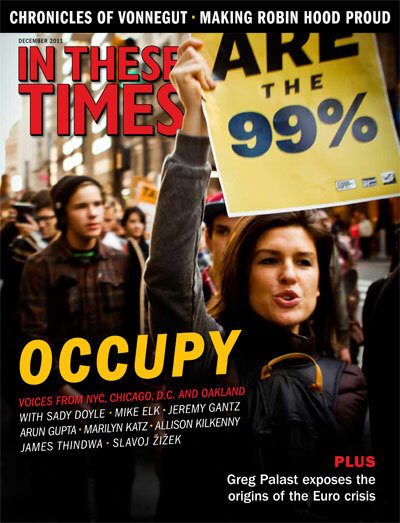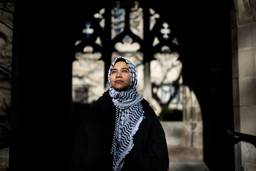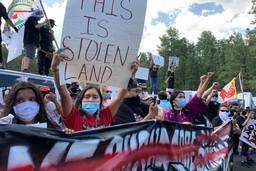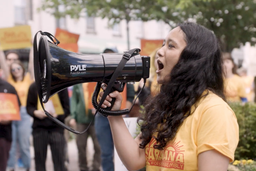New Eden, Old Devils
Occupy sites haven’t yet transcended America’s divisions—but voices of the whole 99% are becoming more audible.
Jude Ellison Sady Doyle

In late October, Time’s tech blog reported a startling fact: Only 30 percent of all people tweeting about Occupy Wall Street were women. This, despite studies showing Twitter users are 64 percent female. The post “Why Aren’t Women Tweeting About Occupy Wall Street?” reached for some conclusions. Maybe women aren’t tweeting about their involvement; maybe female Twitter users aren’t interested in protesting; or maybe they aren’t there.
In fact, women are present at Occupy Wall Street, and in Occupy sites everywhere. And they are doing a tremendous amount of work. For starters, they are trying to provide the basic conditions that make it feasible for more women to participate.
“There have already been sexual assaults in Zuccotti Park,” Amy Klein of the Permanent Wave collective told me in an email, “and many women do not feel safe sleeping there. I’ve heard that women have trouble making announcements at the General Assembly because people interrupt them or shut their dissenting opinions down. … At this point, Occupy Wall Street is so large, it is a microcosm of the outside world – with all of its conditions of inequality.”
Women at Occupy movements have been setting up “safe sleeping spaces,” educating, in their GA speeches, fellow protesters about the meaning of consent; distributing zines that call out certain men who, at the General Assembly, describe sexual harassment a “personal issue”; and creating blogs that spotlight the contributions of women within the movement.
These practical necessities – equal representation; recourse for harassment and assault; a leadership that understands that harassment, assault, and objectification are problems; conditions as basic as childcare for working mothers, or the ability to sleep without fear of being harmed – are easy to overlook. But they’re a crucial part of what makes Occupy spaces functional.
Any radical movement is responsible for breaking down the barriers to participation for marginalized groups. And the Occupy movement is, of course, responsible for breaking down more than one set of barriers.
Many argue that not only Occupy’s participants, but also its basic assumptions and language, have been overwhelmingly white. Manissa McCleave Maharawal writes of having to convince a man not to include the line “one race, the human race” in an official statement: “[It’s] ‘scientifically true’ he told us … we needed to tell him about privilege and racism and oppression and how these things still existed.”
Ernesto Aguilar of People of Color Organize told me: “Hubris – the notion that Occupy has somehow organically undone racial disparity, patriarchy and class divisions after six weeks of camp-outs – is a greater danger than anything external to Occupy. Most people came to this drive with a lifetime of white privilege taught to all races, and even the greatest general assembly ever isn’t going to break down those lessons overnight.”
Groups like Occupy The Hood and the People of Color Occupy Wall Street Work Group have formed in response. They highlight how much the realities of class are tied to race. Jamarhl Crawford, of Occupy the Hood in Boston, has pointed out that police repression and brutality experienced by white Occupy protesters have been “a drop in the bucket” compared to the violence inflicted against communities of color, and that poverty is hardly a mostly-white issue.
Aguilar says Albuquerque’s movement changed its name, to (Un)Occupy Albuquerque, in deference to Native American communities who feel that the “Occupy” language reflects the history of colonialism. The Permanent Wave collective in New York carried a banner at one protest reading “Economic Justice Is A Feminist Issue, Too” – referencing, Klein tells me, the threats to traditionally female public-sector jobs such as nursing and teaching, and threats to vital organizations such as Planned Parenthood made under the cover of cutting spending.
As Occupy moves forward, the voices of the whole 99% – people of color, women, LGBTQ communities, the working-class and poor – are becoming more audible. That they have had to agitate for acceptance points out one crucial fact: When we talk about “occupying,” we can’t ignore that for marginalized people to take up any public space at all is a political act, and often a dangerous one. For these groups to take up that space with their own voices, rather than being spoken for, is a triumph in itself.

I hope you found this article important. Before you leave, I want to ask you to consider supporting our work with a donation. In These Times needs readers like you to help sustain our mission. We don’t depend on—or want—corporate advertising or deep-pocketed billionaires to fund our journalism. We’re supported by you, the reader, so we can focus on covering the issues that matter most to the progressive movement without fear or compromise.
Our work isn’t hidden behind a paywall because of people like you who support our journalism. We want to keep it that way. If you value the work we do and the movements we cover, please consider donating to In These Times.
Jude Ellison Sady Doyle is an In These Times contributing writer. They are the author of Trainwreck: The Women We Love to Hate, Mock, and Fear… and Why (Melville House, 2016) and was the founder of the blog Tiger Beatdown. You can follow them on Twitter at @sadydoyle.








